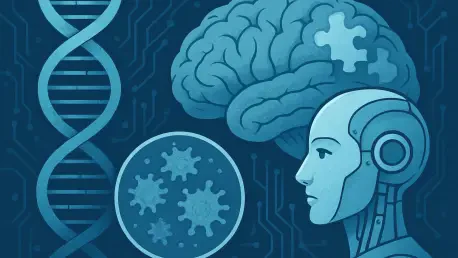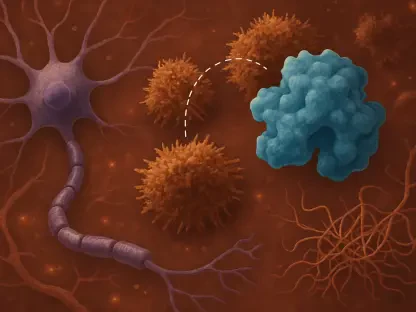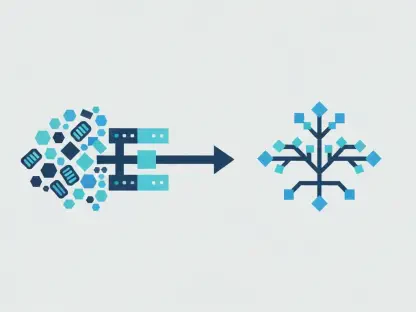The promise of artificial intelligence (AI) in enhancing medical research is becoming increasingly apparent, as recent advancements have brought significant changes to genetic studies related to Alzheimer’s disease. Alzheimer’s is a debilitating condition that progressively erodes memory and cognitive function. Understanding the genetic factors at play is crucial for developing predictive models and targeted therapies. In an innovative leap, machine learning (ML) algorithms are now being harnessed to explore complex genetic interactions in Alzheimer’s research. Unlike traditional Genome-Wide Association Studies (GWAS), which rely heavily on linear models, AI can uncover intricate, nonlinear genetic patterns that may reveal novel insights into disease pathways, potentially revolutionizing the field. This development not only promises to advance the understanding of Alzheimer’s at a genetic level but also aims to improve diagnostic models and therapeutic interventions.
Revolutionizing Genetic Analysis Through Machine Learning
Traditionally, GWAS have served as a cornerstone for identifying genetic variants linked to complex diseases like Alzheimer’s. However, their dependence on linear analytical models limits their capability to detect interactions among multiple genetic factors and their cumulative effect on disease incidence. By integrating machine learning techniques such as Gradient Boosting Machines (GBMs), neural networks informed by biological pathways, and Model-Based Multifactor Dimensionality Reduction (MB-MDR), researchers can now explore these hidden relationships more effectively. Unlike linear models, these artificial intelligence methodologies can capture complex interactions within high-dimensional genetic data.
These advanced models were put to the test in a groundbreaking study to replicate known findings, identify previously unknown Alzheimer’s disease-related genetic loci, and improve individual risk predictions. The results were compelling. The study showed that ML models could replicate 22% of the genetic variants associated with Alzheimer’s identified by larger GWAS meta-analyses using a much smaller sample size. This striking efficiency underscores the potential of ML to make substantial contributions to genetic research, offering new avenues for exploration in Alzheimer’s genetic epidemiology.
Discovering Novel Genetic Variants
AI’s application in Alzheimer’s research has yielded remarkable discoveries, particularly in identifying new genetic loci associated with the disease. The study in question unveiled six novel genetic variants potentially linked to Alzheimer’s risk, which traditional GWAS might have missed. These loci include genes like ARHGAP25, LY6H, and COG7, which are supported by independent datasets, thus bolstering confidence in their relevance to the disease. Each of these genes provides fresh trajectories for exploring Alzheimer’s pathogenesis at the molecular level.
The identification of these novel loci is a testament to the enhanced sensitivity and specificity of machine learning models. By doing so, genetic research is inching closer to uncovering specific disease mechanisms and targeting them effectively in therapeutic interventions. These findings underscore how ML can identify significant genetic contributions without the overwhelming overlap typical of traditional GWAS results. By refining our understanding of genetics in Alzheimer’s, these AI-driven insights also open up potential for personalized treatments aimed at individuals with distinct genetic profiles, further extending the horizons of precision medicine.
Advancements in Predicting Alzheimer’s Risk
In addition to discovering new genetic markers, machine learning models have demonstrated a strong aptitude for predicting Alzheimer’s risk among various populations. The ability to predict disease onset accurately involves not just the identification of relevant genetic markers but also understanding their interactions with various environmental and demographic factors. In practice, ML models like GBMs and Polygenic Risk Scores (PRS) have shown robust performance in classifying individuals at high risk, providing a substantial step forward in predictive genomics.
The models retain their accuracy and consistency even when data is split into different cohorts or when adjusted for potential confounding variables such as age and sex. This robustness suggests that ML could enhance preventive strategies by enabling earlier identification of high-risk individuals who might benefit from early intervention. While conventional methods predict Alzheimer’s with reasonable accuracy, artificial intelligence’s ability to refine inputs and filter noise results in more precise predictions. These predictions could lead to timely lifestyle interventions or medication adjustments, improving long-term outcomes for at-risk patients.
Addressing Challenges and Opportunities
While machine learning boasts transformative potential in Alzheimer’s genetic research, it also poses new challenges that require careful consideration. The complexity of ML models demands that researchers apply these tools with rigorous scrutiny to avoid biases and interpret results with caution. These models can easily overfit to data if not validated properly, leading to misleading conclusions that lack generalizability across different populations. Moreover, the integration of ML necessitates substantial computational resources and expertise to ensure accurate implementation and data handling.
Despite these challenges, the opportunities presented by machine learning are vast. By providing a more detailed understanding of the genetic underpinnings of Alzheimer’s, ML methodologies could direct future research towards promising therapeutic targets and diagnostic markers. Continuous refinement of these techniques is crucial to overcoming present-day limitations. Advancements in AI technology and its application in genetic research will likely drive progress not only in understanding Alzheimer’s but also in tackling other complex diseases, illustrating a broader impact beyond neurology and genetics.
Conclusion: Embracing Future Possibilities
Traditionally, Genome-Wide Association Studies (GWAS) have been pivotal in pinpointing genetic variants that contribute to complex diseases like Alzheimer’s. However, these studies rely on linear analytical models, which struggle to identify interactions among multiple genetic factors and their combined impact on disease development. Modern approaches incorporate machine learning (ML) techniques such as Gradient Boosting Machines (GBMs), neural networks based on biological pathways, and Model-Based Multifactor Dimensionality Reduction (MB-MDR). These advanced ML models more effectively uncover hidden relationships within high-dimensional genetic data compared to linear models. A landmark study tested these ML methodologies to replicate known findings, discover new Alzheimer’s disease-related genetic loci, and enhance individual risk assessments. The results were promising: ML models replicated 22% of Alzheimer’s-associated genetic variants found in larger GWAS meta-analyses, using far smaller samples. This efficiency highlights the potential of ML to significantly advance genetic research and open new paths in Alzheimer’s genetic epidemiology.









